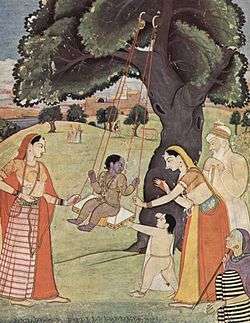Hindu Ghosi
| Hindu Ghosi | |
|---|---|
| Populated States | Bihar, Madhya Pradesh and Uttar Pradesh |
The term Hindu Ghosi (or Ghoshi, Ghosee, Ghosi Thakur, Ghosi Yadav) refers to a community of the Hindu Ahir caste.
In the few Western districts of Uttar Pradesh, the Ghosi Ahirs have been better than others, both in number and influence and hence have attracted the attention of the present political parties. Politicians often plan and expect a split among the different Ahir groups, particularly the Ghosi and Kamariya groups.[1] Kamariyas, who used to live a nomadic lifestyle, and unlike Ghosis were mostly uncivilized, are regarded as having lower status than the Ghosis.[2]
Myth of origin
Ghosi trace their origin to King Nanda, the professed ancestor of Yaduvanshi Ahirs.[3] They also claim their importance saying that the sacred texts have mentioned them under the name of Ghosas.[2] The term Ghosa refers to a settlement of the Abhira people[4] or a temporary encampment of cowherds, which was the occupation of those people.[5]
Colonial description

The largest subdivisions of Ahirs in Braj-Ahirwal area are the Ghosi, Kamariya, Phataks and Nandvanshis. However today they all recognise themselves to be Yaduvanshi or Krishnavanshi Yadavs.[6]
In the Braj-Ahirwal region, the Ghosi and other subdivisions of Ahirs were gradually absorbed into the Nandvanshi category of landlords and into the Yaduvanshi subdivision as a consequence of British so-called "official" ethnographies and racial theories. The landlords liked the Nanvanshi title because they considered it to be prestigious.[7]
Distribution
Ghosi Ahirs are mainly found in Madhya Pradesh, Uttar Pradesh and Bihar states in India. In Utttar the latter two, they usually refer to themselves as Yadavs..[8]
In the Braj-Ahirwal area, the Ghosi are among the largest Ahir subdivisions, along with the Kamariyas, Gwalvanshis and Nandvanshis.[9]
See also
References
- ↑ "UP Polls: Congress trying to get caste calculus right; eyeing Kurmi and Muslim votes - Economic Times". articles.economictimes.indiatimes.com. Retrieved 3 October 2014.
- 1 2 Michelutti, Lucia (2002). Sons of Krishna: the politics of Yadav community formation in a North Indian town (PDF). London School of Economics and Political Science University of London. pp. 94, 95. Retrieved 15 March 2016.
- ↑ Ravindra K. Jain (2002). Between History and Legend: Status and Power in Bundelkhand. Orient Blackswan,. p. 32. ISBN 9788125021940.
- ↑ Roy, Janmajit (2002). Theory of Avatāra and Divinity of Chaitanya. Atlantic Publishers & Dist. p. 157. ISBN 978-8-12690-169-2.
- ↑ Bhattacharya, Sunil Kumar (1996). Krishna-cult in Indian Art. M.D. Publications. p. 126. ISBN 978-8-17533-001-6.
- ↑ Lucia, Michelutti (2002). Sons of Krishna: the politics of Yadav (PDF). London School of Economics and Political Science,University of London. p. 96. Retrieved 12 October 2016.
- ↑ Michelutti, Lucia (2002). "Sons of Krishna: the politics of Yadav community formation in a North Indian town" (PDF). PhD Thesis Social Anthropology. London School of Economics and Political Science University of London. pp. 90–91, 95. Retrieved 2015-05-27.
- ↑ Majeed, Akhtar; Hamdard, Jamia (2000). Coalition politics and power sharing. Manak Publications. Centre for Federal Studies. p. 52. ISBN 978-8-18656-296-3.
- ↑ Michelutti, Lucia (2002). "Sons of Krishna: the politics of Yadav community formation in a North Indian town" (PDF). PhD Thesis Social Anthropology. London School of Economics and Political Science University of London. p. 93. Retrieved 2015-05-27.